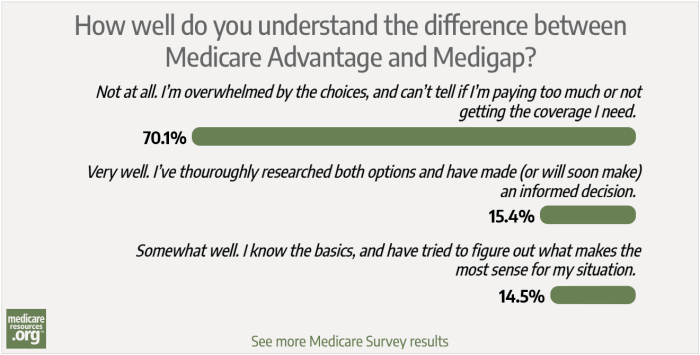What is a Medicare Medical Savings Account (MSA)?
A Medicare Medical Savings Account Plan, also known as a Medicare Advantage MSA, is a type of Medicare Advantage plan that combines a high-deductible health insurance plan with a medical savings account (MSA). MSAs differ from other Medicare Advantage plans in several key ways, which are detailed below.
How do Medicare Medical Savings Accounts work?
An MSA plan has two parts:
- A high-deductible Medicare Advantage health plan, and
- A medical savings account (MSA)
Deposits are made to the MSA by the Medicare Advantage plan using funds that Medicare has given the insurer. Enrollees cannot contribute their own money. The amount that’s deposited into the MSA, and the health plan deductible will vary from one plan to another. But both are prorated if a person enrolls in a Medicare MSA mid-year.
The person enrolled in the Medicare MSA plan can then use the money in the MSA if they have out-of-pocket medical expenses during the year. MSA withdrawals are not taxed as long as they’re used for qualified medical expenses. But if plan holder withdraws the money for anything other than a qualified medical expense, it would be subject to income tax plus a 50% penalty.
Qualified medical expenses are explained in IRS publication 969 and detailed in IRS Publication 502. They include out-of-pocket costs for Medicare-covered services as well as medical services that aren’t covered by Medicare, such as dental and vision care. Qualified medical expenses also include out-of-pocket costs for drugs covered under a separate Medicare Part D plan.
In some ways, the concept of an MSA plan is similar to the high-deductible health plans (HDHPs) and health savings accounts (HSAs) that are available for people who aren’t yet covered by Medicare. But HSA contributions can be made by an employer, the account owner, or anyone else who wants to contribute money to that person’s account, whereas MSA contributions are only made by the person’s Medicare Advantage plan.
What services does a Medicare Advantage MSA plan cover?
Just like all Medicare Advantage plans, MSA Plans have to cover the same services that are covered by Medicare Part A and Part B.
MSA plans can provide coverage for additional benefits, such as dental, vision, and hearing care, but there may be a premium for this extra coverage. The specifics of extra coverage can vary from one plan to another, so you should check with the plan for details.
What doctors can I see if I have an MSA plan?
Unlike other Medicare Advantage plans, MSA plans do not require you to stay within the insurer’s provider network, if there is one. You can see any doctor who accepts Medicare anywhere in the country – as is the case for anyone enrolled in Original Medicare.
Do Medicare MSA plans include prescription drug coverage?
Unlike most Medicare Advantage plans, MSA plans do not include Part D prescription drug coverage. But you can purchase a separate stand-alone Part D plan in addition to the MSA plan. And beneficiaries are allowed to use money in the MSA to pay out-of-pocket costs under the Part D plan, if they choose to do so.
How do I find an MSA plan in my area?
There are very few MSAs available as of 2024, and it appears that MSA plans are only available in Wisconsin in 2024 after the primary carrier that offered these plans in other states discontinued them at the end of 2023. You can see if any MSAs are available in your area by reaching out to a health insurance broker who is certified to offer Medicare Advantage plans, or by using Medicare’s plan finder tool.
If you’re using the Medicare plan finder tool: After entering your zip code, you’ll select Medicare Advantage plans, skip the question about prescription drug costs, and then you’ll get to a screen where there’s a box near the top that says “Plan Type.” That will have a drop-down menu, and if MSAs are available in your area, they’ll be one of the options in that drop-down menu. If MSA isn’t listed, it means there aren’t any available where you live.
When can I enroll in a Medicare Advantage MSA plan?
Just like any other Medicare Advantage plan, the enrollment window to switch to a different plan – including an MSA plan if one is available in your area – runs from Oct. 15 to Dec. 7 each year. This window also allows you to enroll in a stand-alone Part D prescription drug plan, which you’ll need to purchase in addition to the MSA plan since those do not include integrated Part D coverage.
How much are Medicare MSA plan premiums?
There is no separate premium for the Medicare MSA plan. But enrollees pay the Medicare Part B premium ($174.70/month for most enrollees in 2024). And if they want Medicare prescription drug coverage, they also have to pay the premium for a stand-alone Medicare Part D prescription drug plan.
If an enrollee selects a Medicare MSA plan that doesn’t cover dental and vision care, they can choose to purchase stand-alone dental and vision coverage. These plans are not specific to Medicare enrollees, and can be obtained from various insurers. Pricing, coverage details, and plan availability vary.
How high are deductibles on Medicare MSA plans?
The maximum allowable deductible for an MSA is $16,000 in 2024, although plans can have deductibles well below this limit. In 2025, the maximum allowable deductible for MSAs will be $16,350.
These deductible limits are much higher than the overall maximum out-of-pocket limit for other Medicare Advantage plans, which is $8,850 in 2024, and will be $9,350 in 2025.
Of course, the insurer’s contributions to the MSA itself will help to reduce the enrollee’s actual out-of-pocket costs, since they can use the MSA money to cover some of their expenses. But the amount that an insurer contributes to enrollees’ MSAs varies from one plan to another, so it’s important to understand the out-of-pocket costs for the plan you’re considering, as well as the amount that will be deposited into your MSA.
Rolling over unused MSA funds
As is the case with HSAs, unused money remaining in the MSA at the end of the plan year will roll over to the next plan year. If the person keeps the MSA plan, the next year’s deposit will be added to the money that’s already in the account from the prior year’s deposit. But if you leave an MSA plan mid-year, you’ll have to repay a prorated portion of that year’s MSA deposit.
What's the difference between a Medicare Medical Savings Account (MSA) and a Medicare Savings Program?
As described above, a Medicare Medical Savings Account (MSA) Plan is a type of Medicare Advantage plan that combines a high-deductible health plan with a Medical Savings Account funded by the health plan. A Medicare Savings Program is different, and is a way for low-income Medicare beneficiaries to qualify for Medicaid-funded financial assistance with their Medicare premiums and out-of-pocket costs.
Learn how Medicare Savings Programs help with Medicare costs.
Footnotes



